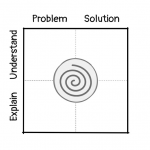 I often find that I give myself pretty good advice as long as I remember to revisit what that advice was.
I often find that I give myself pretty good advice as long as I remember to revisit what that advice was.
Two years ago I read Peter Morville’s Planning for Everything: The Design of Paths and Goals and managed to post a review here—Review: Planning for Everything: The Design of Paths and Goals.
My advice then was that this was a book worth rereading. It is and I just have.
There’s a separate discussion to be had about whether there are better strategies than rereading. I’ll save that for another day.
Morville observes that “while a plan may be defined as a series of steps, planning itself is nonlinear.†This is something that you come to understand over time, but is easily overlooked. You can forget it as an experienced planner because it is down at the level of muscle memory; it happens too fast to be noticeable. It can be harder to discern when you are learning how to plan.
We tend to focus on the artifacts of planning; project charters, statements of work, work plans, schedules, Gantt charts. We gloss over the complexities of developing those artifacts as our understanding of a problem evolves.
This is akin to when we are learning to write complex arguments. How many of us wrote the outlines to our papers after the fact? That’s because we didn’t recognize then that the struggle to find and impose order on our notes and research or the multiple iterations of our opening paragraphs were essential to the creative process. We were inclined to see them as accidental complexities that threatened to reveal our ineptness when, in fact, they were essential to the creative process.
Perhaps this simply reveals my naïveté, but for many years it never occurred to me that books weren’t written in the order that we read them. How did Orwell dream up “it was a bright cold day in April, and the clocks were striking thirteen,†out of thin air?
Our first encounters with plans are much like our first encounters with writing; we see the finished product neatly ordered and polished. The iterations, false starts, and multiple revisions don’t show up in the final product, but they are essential to getting there. Learning to plan, like learning to write, requires rolling around in the messiness. We need to acknowledge and accept that.
Becoming adept at planning is as much about attitude and expectations as it is about technique.
Great line: “learning to plan … requires rolling around in the messiness.†Accepting that and then getting through the messiness faster means more time to clean-up 🙂